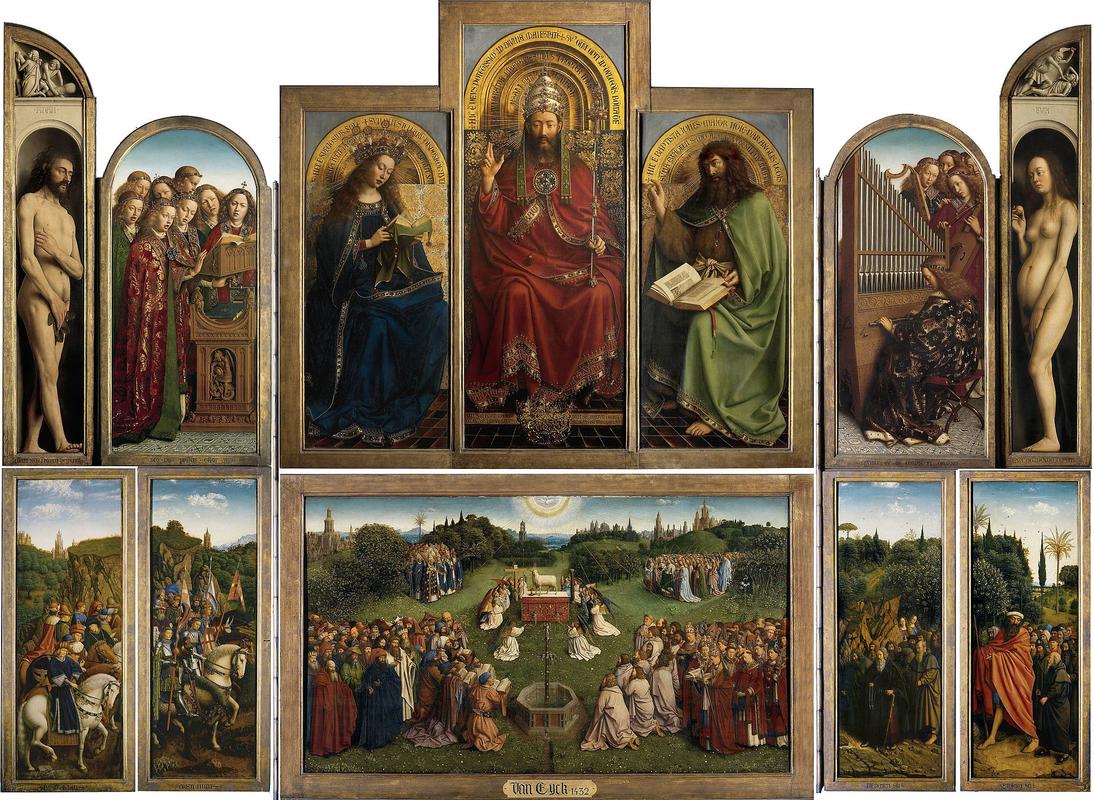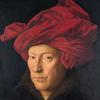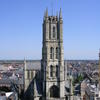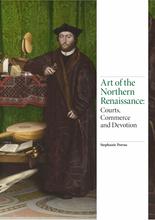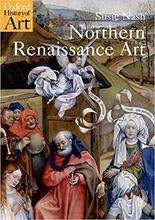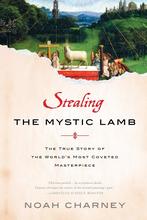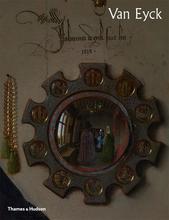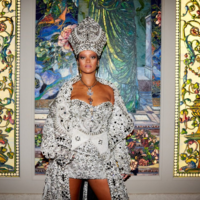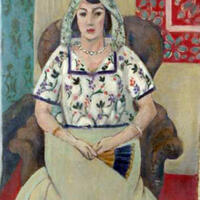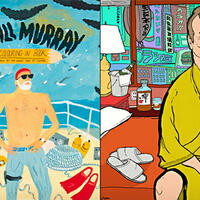More about The Ghent Altarpiece
- All
- Info
- Shop

Contributor
Buckle your seatbelts. The story of the Ghent Altarpiece is a wild ride.
Once upon a time, in a land far, far away, Jan van Eyck painted one of art history’s most famous treasures - the Ghent Altarpiece. More precisely from mid-15th century Flanders, this polyptych spans 15 feet and weighs a little more than your average elephant. It has been the victim of 13 crimes and stolen 7 times, making it the most stolen painting in history. The Ghent Altarpiece certainly puts the runner-up to shame; Rembrandt’s Jacob de Gheyn III has only been stolen four times, and it’s tiny.
In the early 1420s, Jan’s brother Hubert designed an altarpiece for the St. Bavo Cathedral in Ghent, Belgium. The twelve panels chronicle your classic Biblical stories from A to Z. Unfortunately for Hubert, most of the credit now goes to his brother for actually painting the thing. Jan van Eyck was already famous across Europe for pioneering the use of oil paints, which allowed him to render every hair strand, grass blade, fabric fold, and jewel glimmer with acute precision. If you have some serious time on your hands, this fancy science tool digitally documents the entire work at 100 billion pixels for you to peruse every detail. Despite his impressive feat, Jan van Eyck underrated his contribution compared to his brother’s; his inscription calls Hubert “greater than anyone” and himself “second best at art.” Humble.
For one boring century after completion, the Ghent Altarpiece hung in the Cathedral as not much more than a particularly exquisite outcome of brotherly collaboration. You can think of this wholesome tale as the calm before the storm.
Around 1566, all hell broke loose. Calvinists were getting really into destroying symbols of Catholic excess, and with its elaborate frame and gilded pigments, the Ghent Altarpiece was an immediate target. But when the rioters stormed the Cathedral with torches alight, the altarpiece was gone. Guards had quickly disassembled the panels and hidden them away at the top of the tower. The work was safe again… for the moment.
It was Napoleon who started the trend of political leaders stealing the altarpiece. The French army ran wild through Europe in the late-18th century, picking up foreign treasure as they went. The Ghent Altarpiece was snatched up and carted back to the Louvre in Paris, where it was displayed as a symbol of the Republic’s might. Napoleon was eventually defeated, and his successor was a little less flamboyant about his kingly power. He returned the panels to Ghent.
This work cannot catch a break. Shortly after, a vicar of the St. Bavo Cathedral stole the panels and sold them to a collector while his boss was out of town. Apparently he got away with it, since there is no record of any punishment. Then, the Prussian king bought it off the collector to add to his new national museum. The altarpiece was stuck there until World War I. Nice job, vicar.
The work spent World War I hidden in a junkman’s wagon for safekeeping and returned to Ghent when the war ended. You might think that by this time, the St. Bavo Cathedral had really upped its security. Nope. Thieves broke in just sixteen years later and stole one of the panels. It is still missing to this day, and detectives are making little progress on the investigation. The replica that now hangs in its place is so good that some think it’s the original, hidden in plain sight.
Unfortunately for the Ghent Altarpiece, the world had another war. One popular account posits that Hitler thought the work some kind of treasure map showing the locations of religious relics. The more boring and likely possibility is that he just wanted to acquire the world’s greatest treasures. Either way, the Nazis stole the remaining eleven panels and hid them in a salt mine in Austria alongside many other priceless artworks. They were ordered to blow up the entire mine should they lose the war, but thanks to an Allied team tasked with its preservation, the Ghent Altarpiece survived the Nazis’ defeat. We can consider the 2014 George Clooney film “The Monuments Men” a thank-you card.
At last, the work returned to the St. Bavo Cathedral for good, where it continues to hang happily ever after.
The End. We hope.
Sources
- Allsop, Laura. “Website lets world admire ‘Ghent Altarpiece’ in 100 billion pixels.” CNN. March 2, 2012. Accessed December 29, 2017. http://www.cnn.com/2012/03/01/world/europe/ghent-altarpiece-online-open…
- Bevan, Robert. "The Most Stolen Artwork of All Time." Google Arts & Culture. Accessed December 29, 2017. https://www.google.com/culturalinstitute/beta/theme/DQKCAOHVxaa8Lw.
- Charney, Noah. "The Ghent Altarpiece: the truth about the most stolen artwork of all time." The Guardian. December 20, 2013. Accessed December 29, 2017. https://www.theguardian.com/artanddesign/2013/dec/20/ghent-altarpiece-m….
- Charney, Noah. “The Most Frequently Stolen Artwork in History Is.. On the High Line?” The Observer. September 30, 2015. Accessed December 29, 2017. http://observer.com/2015/09/the-most-frequently-stolen-artwork-in-histo… line/
- “Ghent Altarpiece.” Wikipedia. Accessed December 29, 2017. https://en.wikipedia.org/wiki/Ghent_Altarpiece
- “Is This The World’s Most Coveted Painting?” NPR. December 23, 2010. Accessed December 29, 2017. https://www.npr.org/2010/12/25/132283848/is-this-the-worlds-most-covete…
- “Jacob de Gheyn III.” Wikipedia. Accessed December 29, 2017. https://en.wikipedia.org/wiki/Jacob_de_Gheyn_III
- Russeth, Andrew. “Irresistable: How the Ghent Altarpiece Became the World’s Most Frequently Stolen Artwork.” BlouinArtInfo. November 12, 2010. Accessed December 29, 2017. http://www.blouinartinfo.com/news/story/36323/irresistible-how-the-ghen…-
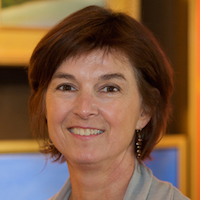
Contributor
The Adoration of the Mystic Lamb by Jan van Eyck is the most stolen work of art ever.
A victim of 13 crimes and 7 thefts.
One of the most important highly coveted artworks in Europe. It has been dismantled, defiled, pawned, damaged by fire, forged, and stolen many times. It was hauled around from country to country- in constant motion for 600 years. It's a miracle it has survived at all.
We think Jan’s older brother Hubert van Eyck worked on the altarpiece, but no one has been able to say for sure which part he did.
The thing is loaded with dozens of obscure symbols. Some believe there's a secret map, others believe it can bestow everlasting life. In the center, there is lamb standing on an altar nonchalantly gushing blood into a chalice.
What's amazing to me is the amount of minute details... from individual strands of hair, to warts, wrinkles, veins and sweat, to beautiful translucent jewels.
Napoleon stole it.
Hitler and his second in command General Hermann Goering fought over it.
Nazis and Allied troops raced each other to get to its hiding place deep in a hidden salt mine. Miners and resistance fighters saved it. Monuments Men returned it to Ghent and is the main storyline of the 2014 film.
As you can imagine, after all the traumatic adventures and crimes, the beautiful altarpiece was in desperate need of restoration.
The Getty Foundation stepped up and has been instrumental in restoration. Check out the website. You can see thousands of images in extreme detail.

Featured Books & Academic Sources
The following is an excerpt from "Van EycK" by J. Cyril M. Weale, published in 1912:
In the centre-piece, "The Adoration of the Lamb," we discover the keynote to the scheme of the work, in the Apocalyptic Vision of St. John the source of its inspiration. The Lamb without spot, the blood from its breast pouring into a chalice, is stood on an altar, the white cloth over which bears on its superfrontal the text from the Vulgate, "Behold the Lamb of God, who taketh away the sins of the world," and on its stole-ends the legend, "Jesus, the Way, the Truth, and the Life." Worshipping angels gather around, some bearing instruments of the Passion, others swinging censers, their smoke laden with the prayers of the saints. In the foreground the Fountain of Life, flowing down through the ages along the gentle slope of flower-bejewelled sward, or dispensing its waters in vivifying jets from the gurgoyles beneath the feet and from the vases in the hands of the winged angel above its standard. To the four quarters groups of the elect: on the near right those of the Old Law and among the Gentiles who had lived in expectation of the Redeemer, the balancing group on the left typical of the New Law—prophets, doctors, philosophers, and princes in the former, the Apostles, popes, bishops, abbots, deacons, monks, and clerics among the latter. The corresponding groups back of the altar represent the army of martyrs whose blood is the seed of the Church, and the multitude of virgins. Over all, from the Holy Dove poised high over the altar, dart rays of light, emblematic of the Wisdom which had inspired their lives and of the fire of Love that had heartened their sacrifice. A carpet of flowers fills in all the open space fore of the altar, flowering shrubs and trees that of the mid-distance, while the entire background is an exquisite example of the realistic landscape-work that is an abiding charm of the Netherlandish school. The wonderful harmony of colour appeals at once to the senses; but more arresting, on nearer acquaintance, for its quality and felicity, is the wide range of portraiture that distinguishes the piece. From the two lateral panels in the dexter shutter the Knights of Christ and the Just Judges are pressing forward to the scene of the Vision, from the corresponding ones in the sinister shutter the Holy Hermits and the Holy Pilgrims: the former on spirited horses—an animal for which the painter evinces a special affection—the latter on foot. These panels are even more remarkable perhaps than the centre-piece for the diversity and multiplicity of the types portrayed, and for the wealth of landscape relieved by bird life lavished in their embellishment.
The "Adoration of the Lamb" is dominated in the upper zone by a triple panel, the centre framing the Almighty enthroned in majesty, whose is the kingdom, the power, and the glory—a supreme conception of the Eternal Father, unequalled for majestic stillness of face, intellectual power of brow, and depth and placidity of vision; on His right is the Mother of Christ, testifying to the full the lowliness of the handmaiden of the Lord, on His left St. John the Baptist, an earnest type, long of hair and rugged of beard, barefooted, and in a raiment of brown camel's hair girdled about the loins, intensifying the austerity of life ordained for him who was to prepare the way of the Lord and make straight His paths. In the "Choir of Angels," which is the subject of the first lateral panel in the dexter shutter, we have one of the choicest gems of the polyptych, and it affords us a measure of the distance the realistic tendencies of the painter had carried him from the traditions of the mystic school. Justified by the warrant of Scripture, he translates these spirit beings into purely human frames, but with a nerve system attuned to material sensations. In these angels there is no suggestion of trance-like ecstasy in contemplation of the Beatific Vision; they are angels materialised whose features reflect the strain of sustained effort and the underlying sense of pain which in man is inseparable from the sensing of intense joy. Evidently the master had fathomed the secrets of the human heart: the sense possibilities of the spirit world were without his ken, so he humanised his angels and evolved types understandable of the people, and at the same time one of the finest angel groups of all art. So inexpressibly realistic are his conceptions that to the poet-biographer Van Mander, at any rate, it was actually possible to discern "the different key in which the voice of each is pitched." But poets are privileged beings. Accompanying the Choir in their song of praise with organ, harp, and viol are the balancing group of angels in the corresponding compartment of the sinister shutter, types that, strangely enough, are in striking contrast to the former, their features moulded in placid contentment. The extreme panels of this zone are occupied by life-size presentations of our First Parents after the Fall, nude figures painted from the life, with absolute fidelity to nature and masterly conception of type: in a demi-lunette over the figure of Adam we see Cain and Abel making their offerings unto the Lord, and in that over Eve the slaying of Abel at the hands of his brother. There is a tradition extant that the altar-piece was originally furnished with a predella painted in distemper, a picture probably of Limbo or of Purgatory, but no trace of this remains.
The closed shutters display, filling in the full width of the middle zone, the scene of the Annunciation. The Ethyrean Sibyl and the Cumaean Sibyl occupy the demi-lunettes above the middle portion of the Virgin's chamber, the lunettes above the lateral divisions showing half-length figures of the Prophets Zacharias and Micheas. Of the four compartments of the lower zone the inner ones contain statues in grisaille of St. John the Baptist and St. John the Evangelist, the outer ones figures in the attitude of prayer, eminently life-like, of the donor, Jodoc Vyt, and his wife, Elizabeth Borluut. Jodoc was the second son of Sir Nicholas Vyt, Receiver of Flanders,—a wealthy citizen who owned the lordships of Pamele and Leedberghe, besides several mansions in Ghent, of which city he was burgomaster in 1433-34, after filling various minor municipal offices: by no means a handsome type, though manifestly a capable and kindly burgher, well-set, with a somewhat low forehead, small grey eyes, and a large mouth with broad under-lip; neither do the short-cropped hair and growing baldness or the three warts on upper-lip, nose, and forehead make for attractiveness. In respect of looks his wife is the better favoured, striking the beholder as an indulgent lady, with much of the homely dignity and serenity of the finer type of Flemish matron.
The Great Polyptych had not yet reached completion when, on the 18th of September 1426 Hubert van Eyck passed away after a painful illness. How much of the work remained to be accomplished none can tell with any hope of approach to certainty. A whole volume would not suffice for a critical examination of the mass of contending theories that for the best part of a century has been squandered in the endeavour to allocate to the two brothers their respective shares in the execution of the picture. Remember that it had already been some ten years in the making, and that, although it did not receive its final touches from the brush of John van Eyck until 1432, nearly six years after his brother's death, this period of John's life, as we shall presently discover, was too fully occupied in the service of Duke Philip of Burgundy to have allowed of his spending any considerable proportion of it in the task of completion. Remembering also that John's art had been closely modelled on that of his brother, that none better comprehended his ideals or was more intimately acquainted with the working out of his conceptions, mindful, moreover, of the deep veneration in which he held his master's genius, we must suppose that he realised the obligation of conscientiously adhering to the art and technique of the picture as he found it, any obtruding originality in violation of which would have amounted almost to sacrilege: all this further enhances the difficulty of differentiating between the work of the two painters. Indeed, if so minded, the reader is probably as well equipped as the writer to solve the puzzle.
Sources
- Weale, J. Cyril M. Van Eyck. New York: Frederick A. Stokes Co., 1912.
Featured Content
Here is what Wikipedia says about Ghent Altarpiece


The Ghent Altarpiece, also called the Adoration of the Mystic Lamb (Dutch: De aanbidding van het Lam Gods), is a very large and complex 15th-century polyptych altarpiece in St Bavo's Cathedral, Ghent, Belgium. It was begun around the mid-1420s and completed by 1432, and it is attributed to the Early Netherlandish painters and brothers Hubert and Jan van Eyck. The altarpiece is a prominent example of the transition from Middle Age to Renaissance art and is considered a masterpiece of European art, identified by some as "the first major oil painting."
The panels are organised in two vertical registers, each with double sets of foldable wings containing inner and outer panel paintings. The upper register of the inner panels represent the heavenly redemption, and include the central classical Deësis arrangement of God (identified either as Christ the King or God the Father), flanked by the Virgin Mary and John the Baptist. They are flanked in the next panels by angels playing music and, on the far outermost panels, the figures of Adam and Eve. The central panel of the lower register shows a gathering of saints, sinners, clergy, and soldiers attendant at an adoration of the Lamb of God. There are several groupings of figures, overseen by the dove of the Holy Spirit. The four lower panels of the closed altar are divided into two pairs; sculptural grisaille paintings of St John the Baptist and St John the Evangelist, and on the two outer panels, donor portraits of Joost Vijdt and his wife Lysbette Borluut; in the upper row are the archangel Gabriel and the Annunciation, and at the very top are the prophets and sibyls. The altarpiece is one of the most renowned and important artworks in European history.
Art historians generally agree that the overall structure was designed by Hubert during or before the mid-1420s, probably before 1422, and that the panels were painted by his younger brother Jan. Yet, while generations of art historians have attempted to attribute specific passages to either brother, no convincing separation has been established, it may be that Jan finished panels begun by Hubert.
The altarpiece was commissioned by the merchant and Ghent mayor Jodocus Vijd and his wife Lysbette as part of a larger project for the Saint Bavo Cathedral chapel. The altarpiece's installation was officially celebrated on 6 May 1432. It was much later moved for security reasons to the principal cathedral chapel, where it remains.
Indebted to the International Gothic as well as Byzantine and Romanic traditions, the altarpiece represented a significant advancement in western art, in which the idealisation of the medieval tradition gives way to an exacting observation of nature and human representation. A now lost inscription on the frame stated that Hubert van Eyck maior quo nemo repertus (greater than anyone) started the altarpiece, but that Jan van Eyck—calling himself arte secundus (second best in the art)—completed it in 1432. The altarpiece is in its original location, while its original, very ornate, carved outer frame and surround, presumably harmonizing with the painted tracery, was destroyed during the Reformation; it may have included clockwork mechanisms for moving the shutters and even for playing music.
Check out the full Wikipedia article about Ghent Altarpiece

